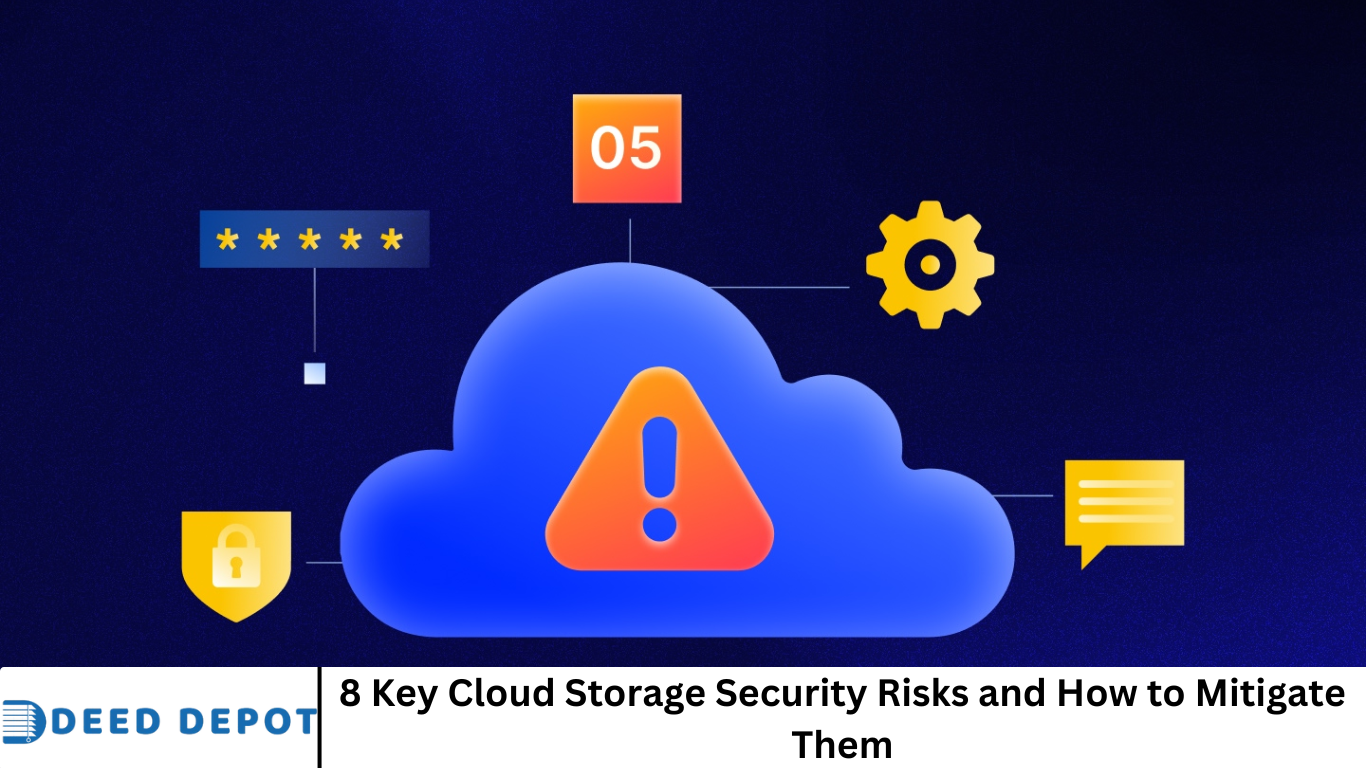Cloud storage offers scalability, accessibility, and cost-efficiency—but these benefits come with serious security challenges. Below, we explore eight major risks organizations face when storing data in the cloud, illustrated with recent real-world incidents and clear mitigation strategies.
More Read: Top 2025 World Backup Day Quotes from Industry Leaders
1. Misconfigurations
Cloud misconfigurations—like public S3 buckets or default settings—are among the most frequent causes of data leaks.
Example:
In March 2025, a misconfigured AWS S3 bucket at ESHYFT, a US health‑tech company, exposed over 86,000 healthcare records, including sensitive PII and medical documentation.
Risk: Public exposure of sensitive data.
Mitigation:
- Apply the Principle of Least Privilege (PoLP): grant only essential access.
- Use Infrastructure-as-Code (Terraform, CloudFormation) to enforce consistent setups.
- Regular scans with Cloud Security Posture Management (CSPM) tools to detect issues.
- Periodic audits and peer review of IAM policies and IaC scripts .
2. Data Breaches & Account Hijacking
Credential compromises through phishing, brute-force, or malware remain critical threats.
Example:
The 2024 Snowflake breach affected over 160 customer environments. Attackers exploited stolen credentials not protected by multi-factor authentication (MFA).
Similarly, the 2025 Gravy Analytics breach saw hackers access precise location data stored in AWS S3.
Risk: Unauthorized access, data theft, reputational harm, compliance violations.
Mitigation:
- Always enable MFA, especially on privileged accounts.
- Use identity management systems (Oauth, RBAC) with frequent privilege reviews .
- Monitor user behavior and flag anomalies via User Behavior Analytics (UBA).
- Harden authentication with strong, unique passwords stored securely.
3. Insecure Interfaces/API Vulnerabilities
APIs are the glue of cloud operations—but poorly secured APIs are prime attack surfaces.
Risk: Injection attacks, unauthorized code execution, data manipulation.
Mitigation:
- Use API gateways with input validation, throttling, and encryption .
- Add Web Application Firewalls (WAFs) to block malicious requests .
- Fully log and monitor all API calls for anomalies.
- Employ rate limiting to thwart brute-force and DoS vectors.
4. Denial-of-Service (DoS/DDoS) Attacks
While cloud architectures offer resilience, they are still vulnerable to volumetric and application-level DoS.
Risk: Service outages, business disruption, competitive loss.
Mitigation:
- Deploy always-on DDoS protection with traffic filtering and scrubbing.
- Build redundancy: multi-zone load balancers and failover systems .
- Regularly run stress tests to validate scalability .
- Prepare a DoS-specific incident response plan .
5. Malware & Ransomware
Malicious software injected via email, third-party integrations or compromised images can jeopardize cloud integrity.
Risk: Data theft, persistence of malicious code, regulatory non-compliance.
Mitigation:
- Deploy cloud-aware antivirus and malware detection tools .
- Segment internal networks to limit lateral spread .
- Enforce MFA to mitigate compromised access .
- Back up data frequently and test restores regularly .
- Adopt Zero-Trust models: assume no device or actor is inherently trustworthy .
6. Insider Threats
Employees—malicious or accidental—pose major risks. According to Verizon, insiders accounted for 83% of 2022 breaches.
Examples:
- Snowflake breach involved credential theft from employees lacking MFA .
Risk: Unauthorized exfiltration, systems sabotage, privilege escalation.
Mitigation:
- Conduct thorough background checks for sensitive roles.
- Apply PoLP and revoke access immediately upon role changes .
- Use UBA to spot abnormal user actions .
- Enforce DLP, phishing awareness, anti-insider policies and regular training.
7. Insufficient Encryption
Failure to encrypt data properly at rest or in transit weakens defenses and may breach regulations.
Risk: Data readable by malicious insiders or interceptors; potential non-compliance.
Mitigation:
- Use end-to-end encryption (AES‑256 or better) for sensitive datasets .
- Manage keys securely via HSMs or KMS.
- Regularly rotate keys and retire old ones .
- Audit encryption methods and enforce full encryption of backups and replicas .
8. Weak Patch Management
Unpatched systems are easy targets. Attackers exploit unaddressed vulnerabilities in software and OS components .
Example:
In March 2025, CISA warned of a critical zero-day in Commvault’s Metallic (on Azure). The vulnerability, CVE-2025-3928, allowed remote access via exposed client secrets.
Risk: Unauthorized access, supply-chain attacks, lateral movement.
Mitigation:
- Deploy automated patch management tools across all cloud assets.
- Conduct frequent vulnerability scans (CSPM, SIEM) and prioritize fixes .
- Define SLA-aligned patch windows for critical assets .
- Stay informed via vendor advisories and threat intelligence .
🔄 Shared‑Responsibility & Compliance: The Ongoing Challenge
A common oversight is misunderstanding CSPs’ shared‑responsibility model—providers secure the infrastructure, but customers handle data, apps, and access security.
Mitigation:
- Define clear roles and responsibilities in internal documents and contracts .
- Use CSP tools to audit compliance (e.g. AWS Audit Manager, Azure Policy).
- Ensure regulatory adherence (GDPR, HIPAA, PCI‑DSS) via audits and encryption.
🌐 Real-World Breach Examples Recap
| Breach | Cause | Impact |
|---|---|---|
| ESHYFT (Mar 2025) | Unsecured S3 bucket | 86K+ healthcare records exposed |
| Snowflake (2024) | Credential theft without MFA | 160+ customer environments breached |
| Gravy Analytics (Jan 2025) | AWS cloud breach | Millions of location data points stolen |
| Commvault (2025) | Zero-day CVE exploit | Credentials leaked, global SaaS risk |
✅ Risk Mitigation Summary
- Automate configuration and enforce PoLP
- Mandate MFA + IAM hygiene
- Secure APIs & interfaces
- Prepare with DDoS defences
- Detect malware & implement Zero‑Trust
- Monitor insiders & apply DLP
- Encrypt comprehensively & manage keys
- Automate patching & track advisories
- Clarify shared‑responsibility and embed compliance
- Institute continuous logging, audits & staff training
Adopted together, these practices form a robust cloud storage security posture—guarding against breaches, safeguarding data, protecting reputation, and ensuring regulatory compliance.
Frequently Asked Question
What are the most common cloud storage security risks?
The most common cloud storage security risks include:
- Misconfigured cloud settings
- Data breaches due to credential theft
- Insecure APIs
- DDoS attacks
- Malware and ransomware
- Insider threats
- Weak encryption
- Unpatched vulnerabilities
Each of these risks can lead to data loss, system downtime, or regulatory violations if not properly mitigated.
How can misconfigured cloud storage lead to data breaches?
Misconfigurations, such as leaving storage buckets public or assigning overly broad permissions, can expose sensitive data to the internet. Attackers often scan for these misconfigurations using automated tools. To prevent breaches, it’s critical to audit settings regularly and apply the principle of least privilege.
What’s the best way to protect cloud storage from ransomware attacks?
To protect against ransomware in cloud environments:
- Enable robust endpoint protection
- Use cloud-native malware detection tools
- Segment networks to limit lateral spread
- Back up data frequently with immutable storage
- Apply zero-trust principles and limit access
Why is multi-factor authentication (MFA) important in cloud security?
MFA adds an extra layer of protection beyond passwords. Even if credentials are stolen, attackers can’t access cloud systems without the second verification step. Enabling MFA for all accounts—especially admins—is one of the most effective ways to prevent unauthorized access.
How can organizations secure their APIs in the cloud?
To secure cloud APIs:
- Enforce authentication and access control
- Use API gateways with rate limiting and input validation
- Implement logging and monitoring of API activity
- Conduct regular penetration testing
These steps prevent attackers from exploiting API vulnerabilities.
What role does encryption play in cloud storage security?
Encryption ensures that even if data is intercepted or accessed without permission, it remains unreadable. Encrypt data both at rest and in transit using strong algorithms (like AES-256). Secure key management is equally important—use cloud provider key management services (KMS) or hardware security modules (HSMs).
How can organizations manage insider threats in cloud environments?
To mitigate insider threats:
- Monitor user behavior with UBA tools
- Restrict access using role-based access control (RBAC)
- Conduct regular audits and permission reviews
- Train employees on security best practices
- Implement data loss prevention (DLP) tools
Conclusion
Cloud storage risks—from public bucket misconfigurations, weak APIs, and insider threats, to encryption lapses and unpatched vulnerabilities—must be proactively managed. The examples above demonstrate how rapidly small oversights can escalate into major incidents. By systematically enforcing best practices—strong identity controls, encryption, monitoring, patch management, DLP, and clear shared-responsibility—you can securely reap the benefits of cloud storage.


